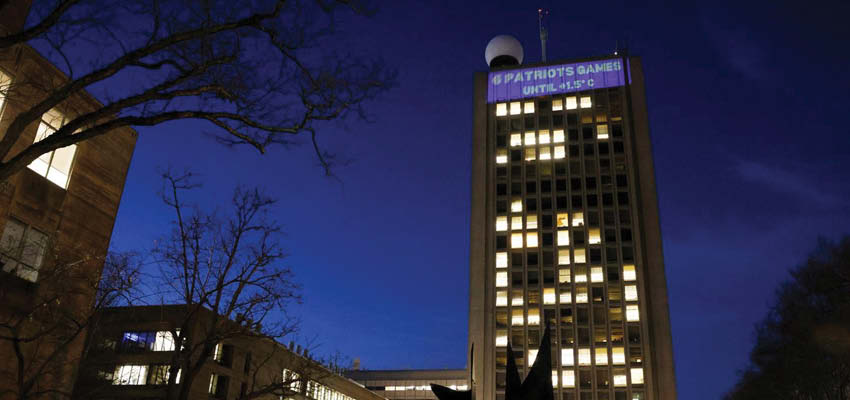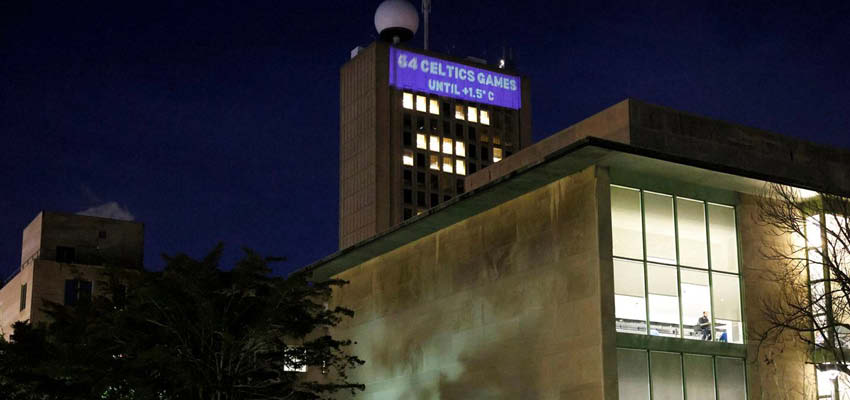
Designed by an MIT student, the climate clock uses Celtics games and other local units of measurement to countdown to a dire tipping point
As world leaders gather for the United Nations annual climate conference this year in Dubai, people in Boston and Cambridge are being confronted by a dire reminder of the stakes.
From Nov. 30 to Dec. 12, the Massachusetts Institute of Technology’s Climate Clock Team is projecting a massive clock, roughly 80 by 20 feet in size, onto the south face of the campus’s Green building, the second-tallest structure in Cambridge and home to the university’s Earth, Atmosphere, and Planetary Sciences department.
The clock, designed by MIT second-year student Norah Miller, counts down to the projected date and time that the planet is expected to have warmed by 1.5 degrees Celsius — 2.7 degrees Fahrenheit — over preindustrial levels. That would mark a threshold climate scientists warn should be avoided to prevent worsening, and potentially irreversible, impacts from global warming, such as more intense wildfires, heat, droughts, and storms.
At the UN’s climate summit in Paris in 2015, countries agreed to keep global warming “well below 2 degrees Celsius,” while also pursuing efforts to limit the rise to no more than 1.5 degrees Celsius.
The planet has already warmed about 1.2 degrees Celsius. The World Meteorological Organization warns that there’s a 66 percent chance the world will reach 1.5 degrees of warming, at least temporarily, within the next five years, and global temperatures could swing between 1.1 and 1.8 degrees higher over preindustrial levels during that time.
This year’s climate clock is the third at MIT but the first designed fully by students. It will be visible at night across the Charles River in Boston from sunset to sunrise.
But unlike more traditional doomsday clocks used by scientists, this latest one uses a decidedly local, non-traditional countdown method. The MIT clock projects the number of Boston sports teams’ games before the clock hits May 2024, a worst-case scenario for the 1.5 degree mark as heat-trapping pollution and an El Niño event warm the planet.
“Someone might get that there are six Pats games until this event. That makes a lot more sense to people,” said Miller. “It’s a sense of personal urgency.”
Or, Sox fans, for example, can see that world leaders need to come together at COP28 in Dubai and take serious action before the Red Sox play about 30 games next spring.

Even though the stakes are huge, Miller chose a purple background for this year’s clock to step away from the connotations of green and red — colors used for previous clocks — where red denotes abject failure. Climate scientists have long stressed that the goal is to limit warming as much as possible, but not to give up and declare defeat if a certain marker is missed.
The climate clock originated in MIT D-Lab, a multidisciplinary suite of classes where students design socially and environmentally-conscious projects to address issues of global poverty.
Susan Murcott, a professor of environmental engineering who teaches a D-Lab course, has worked closely with the climate clock teams since students came up with the concept three years ago. Projections began in April 2021 during Earth Week and continue twice annually, during Earth Weeks and the UN’s COP summits each November.
But this year’s clock has a message that is both accessible and urgent, Murcott said. “I think of it as a message like ‘the British are coming’,” she said. “It’s serious. It’s something you want to know.”
A permanent projection of MIT’s climate clock will begin in 2024 and will continue even if warming exceeds 1.5 degrees Celsius, Murcott said. It is important for the clock to “continue to serve as a wake-up call, to let people know where we stand in terms of the challenge we face,” she said. Additionally, students will continue to play a role in the climate clock’s message.
“That’s kind of what I care about with the climate clock going forward,” Murcott said. “It will not just be administration messages … I wanted to make sure there was diversity — student diversity.”
“It’s [younger] generations that will be equally-most impacted,” Murcott said about the climate crisis. “It’s so important that young people take action.”
More information
MIT D-Lab class: D-Lab Climate Change and Planetary Health
Contact
Susan Murcott, MIT D-Lab Lecturer

